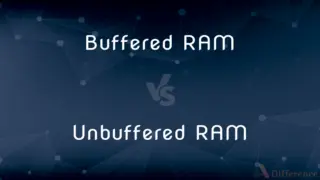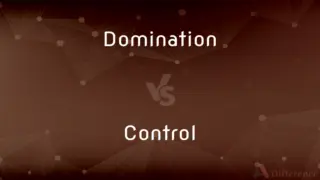Natural Selection vs. Artificial Selection — What's the Difference?
By Tayyaba Rehman — Published on October 29, 2023
Natural Selection operates autonomously via survival and reproductive success, while Artificial Selection involves human intervention to select desirable traits, guiding species' development.

Difference Between Natural Selection and Artificial Selection
Table of Contents
ADVERTISEMENT
Key Differences
Natural Selection and Artificial Selection delineate two distinct pathways of evolutionary change within species. Natural Selection represents an automatic process, governed by environmental factors, where certain traits become prevalent due to increased survival and reproductive advantage. In contrast, Artificial Selection is characterized by intentional human interference, selectively breeding organisms to promote specific traits within the progeny.
The origins of Natural Selection can be traced to Charles Darwin, elucidating an inexorable process dictating species’ adaptation and evolution. In stark contrast, Artificial Selection is a practice arguably as old as human agriculture itself, wherein people purposefully cultivate plants and animals with desirable characteristics, thereby sculpting their genetic trajectories.
It is crucial to acknowledge that Natural Selection unfolds over prolonged temporal spans, incidentally fostering advantageous traits’ propagation. On the other hand, Artificial Selection is often rapidly discernible across a few generations, owing to the deliberate selection and breeding of organisms possessing sought-after attributes.
Natural Selection takes no cognizance of beneficial future outcomes for species; it is an inadvertent product of survival and reproductive variance amid extant populations. Conversely, Artificial Selection is essentially forward-looking, with humans envisioning a specific genetic future or outcome for a species and intervening to facilitate this.
While both Natural Selection and Artificial Selection modify species’ genetic compositions, their ethical dimensions diverge. Natural Selection does not invite ethical scrutinization as it is devoid of conscious intent. In contrast, Artificial Selection is often subjected to ethical examination, contemplating the implications and responsibilities of manipulating species’ genetic futures.
ADVERTISEMENT
Comparison Chart
Agent of Selection
Environment/Nature
Humans
Purpose
Non-purposeful; survival and reproduction-oriented
Purposeful; aimed at enhancing specific traits
Speed of Change
Generally slow and over many generations
Can be rapid and observable in fewer generations
Direction
Non-directional; adaptive to environmental changes
Directional toward human-desired traits
Ethical Concerns
Typically none, due to lack of conscious intervention
Present, due to direct genetic intervention
Compare with Definitions
Natural Selection
Evolution driven by environmental factors.
Through Natural Selection, desert plants developed adaptations to conserve water.
Artificial Selection
Deliberate breeding to enhance particular traits.
Through Artificial Selection, farmers developed numerous breeds of dogs.
Natural Selection
Adaptive changes stemming from reproductive advantages.
Natural Selection facilitated the emergence of differing beak sizes among Galapagos finches.
Artificial Selection
Human-directed development of species’ characteristics.
Artificial Selection enabled the cultivation of various tomato sizes and colors.
Natural Selection
The unintentional survival and reproduction of the fittest.
Natural Selection led to the dominance of camouflage traits in certain animals.
Artificial Selection
Purposeful manipulation of reproductive practices.
Artificial Selection in horse breeding seeks to produce faster runners.
Natural Selection
A non-directed process determining species’ genetic evolution.
Natural Selection inadvertently fostered the proliferation of antibiotic-resistant bacteria.
Artificial Selection
Intentional interference in species’ genetic development.
Artificial Selection has vastly modified the original wild mustard plant.
Natural Selection
Incremental genetic shifts prompted by survival disparities.
Natural Selection enabled polar bears to develop insulating white fur.
Artificial Selection
The controlled propagation of chosen traits.
Through Artificial Selection, seedless grapes were developed for convenience.
Common Curiosities
Why do humans engage in Artificial Selection?
Humans utilize Artificial Selection to breed organisms with traits deemed desirable or beneficial.
Is Natural Selection always beneficial for species?
Not necessarily; Natural Selection fosters traits advantageous under current conditions, which can change.
Can Natural Selection work on domesticated animals?
Yes, Natural Selection can act on any reproducing population, though its effects may be mitigated by human care.
What is a common example of Artificial Selection?
Dog breeding, where specific breeds are created via Artificial Selection, is a prevalent example.
Can Natural Selection create new species?
Yes, over time, Natural Selection can lead to speciation, where populations diverge into separate species.
Can Artificial Selection have negative consequences?
Yes, Artificial Selection can inadvertently promote harmful genetic traits or reduce genetic diversity.
Is Natural Selection a conscious process?
No, Natural Selection lacks intent and progresses autonomously, guided by environmental factors.
Can Artificial Selection be ethical?
The ethics of Artificial Selection can be subjective and depend on purposes, methods, and impacts.
How does Natural Selection occur without intervention?
Natural Selection transpires through survival and reproductive advantages amidst environmental challenges.
Is Artificial Selection only applicable to animals?
No, Artificial Selection is widely applied to both animals and plants for varied purposes.
How does Natural Selection impact genetic diversity?
Natural Selection can enhance or deplete genetic diversity, contingent upon the traits being selected.
Can Natural Selection and Artificial Selection occur simultaneously?
Yes, both processes can concurrently influence populations, though their effects might counterbalance.
How does Artificial Selection affect biodiversity?
Artificial Selection can either decrease biodiversity through uniform breeding or increase it by creating new breeds.
How long has Artificial Selection been practiced?
Artificial Selection has been practiced for thousands of years, notably in agriculture and animal breeding.
Does Natural Selection have a predefined purpose or end goal?
No, Natural Selection operates without foresight, influencing species based on current reproductive success.
Share Your Discovery

Previous Comparison
Buffered RAM vs. Unbuffered RAM
Next Comparison
Domination vs. ControlAuthor Spotlight
Written by
Tayyaba RehmanTayyaba Rehman is a distinguished writer, currently serving as a primary contributor to askdifference.com. As a researcher in semantics and etymology, Tayyaba's passion for the complexity of languages and their distinctions has found a perfect home on the platform. Tayyaba delves into the intricacies of language, distinguishing between commonly confused words and phrases, thereby providing clarity for readers worldwide.













































